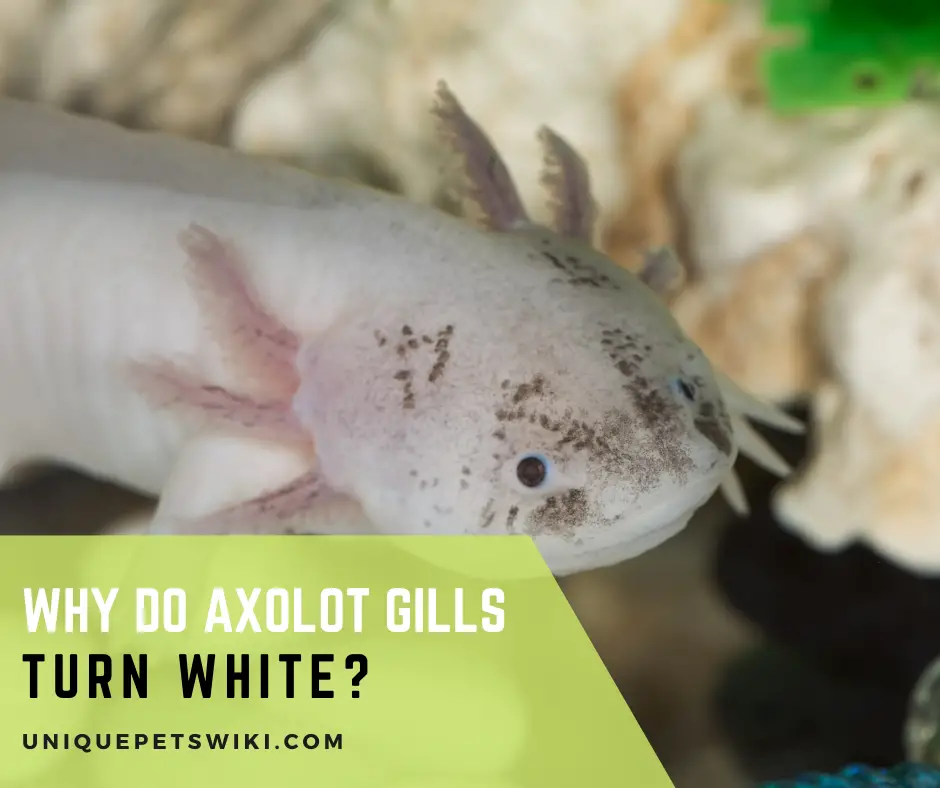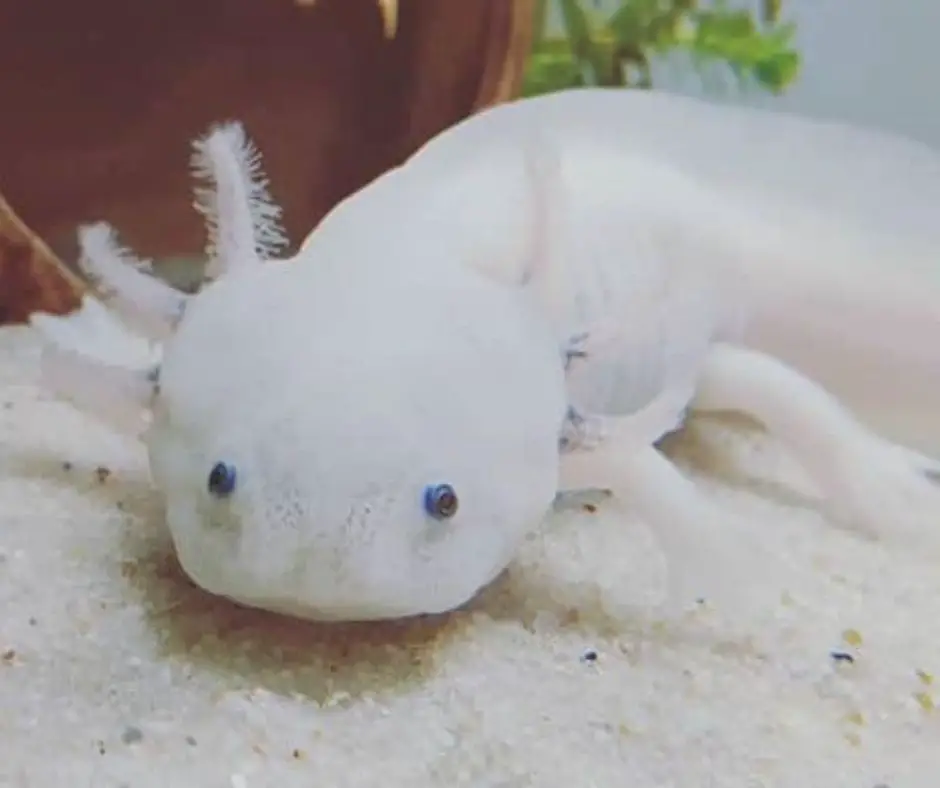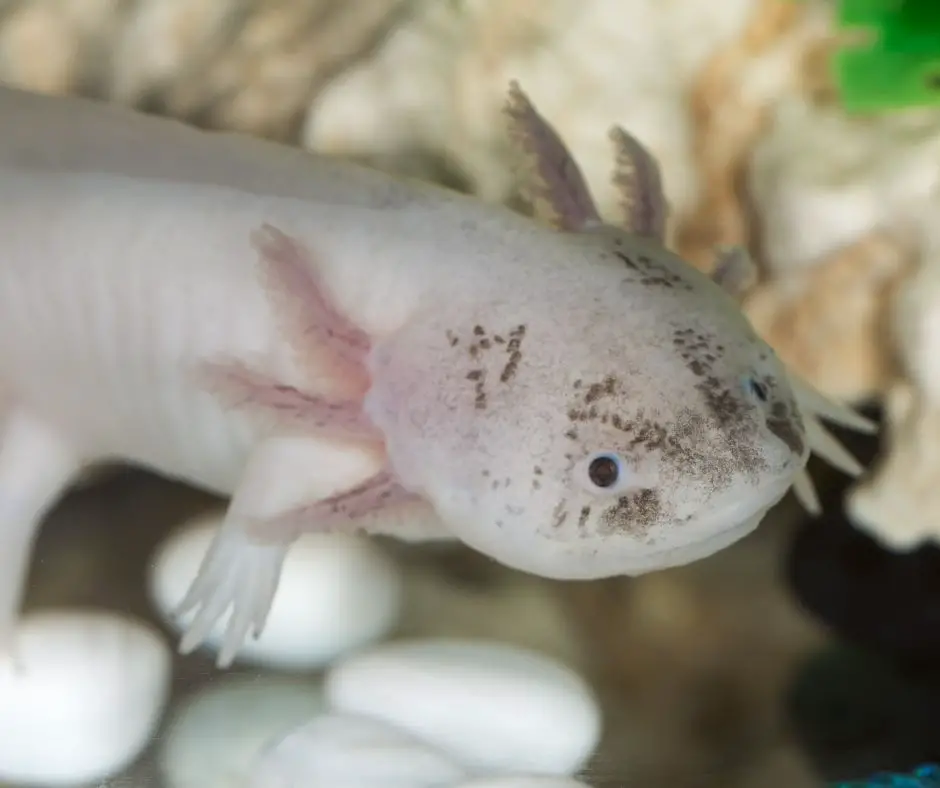This article has been reviewed and approved by Dr. Dilber. Read more about our knowledge control process here.

Axolotls are delicate and exotic pets and if you have one, it can be very satisfying to watch your pet grow and thrive.
But if you’re wondering ‘why do axolotl gills turn white’, then there may be a chance that your pet is not keeping well.
Worry not, this guide explains exactly when to be concerned if your axolotl’s gills are turning white and when to see the vet for it.
Contents
Why Do Axolotl Gills Turn White?
Many times, axolotl gills may turn white for innocuous reasons and there may be nothing to worry about. Often, their gills become colorless or pale due to periods of inactivity. Once your pet is active and feeding again, its gills will become normal. In some cases though, a disease or a fungal infection could be the cause of axolotl gills turning white.
Also read: Full Requirements & Water Conditions for Axolotl in Captivity

Inactive or Sleeping
Axolotls sleep and since they don’t have eyelids, it may be difficult to know when your pet is asleep Most axies sleep at night and are more active during the day. You might find your pet floating about in the dark spot in its tank.
Sometimes, their gills may appear colorless in the early morning after they have just woken up.
In fact; their entire body may appear pale or colorless due to the reduced blood flow that causes their translucent skin to appear lighter than usual.
But once your pet starts swimming and eating, its gills should return to their normal, healthy color.
What to do
- You can try putting some food in one end of the tank and get your axolotl to move. This should change its gills back to their healthy color.
- You could also interact with your pet. This will cause their heartbeat to increase and get your pet’s blood flow back to normal. This should restore the gills to their normal color.
Poor Water Conditions
Poor water conditions can also cause white gills in axolotls.
The tank’s ammonia and nitrites may be greater than 0 ppm or the nitrates may have gone over 40 ppm.
If ammonia and nitrites are in excess and the water is dirty, then your pet could get sick. It may refuse food and become lethargic or inactive. It might also float. Its gills will appear dull and colorless.
What to do
- Make sure to clean away the tank algae regularly.
- Make regular water changes- at least 70-80%.
- You could also try raising the water temperature a little. This should get your pet to move and that may restore the color of their gills.
Tetra Whisper IQ Power Filter for Aquariums
- QUIET AQUARIUM FILTER: The Tetra Whisper IQ Power Filter with Stay Clean technology contains a sound shield for quiet filtration less than 40 dB.
- SELF PRIMING: Submerged motor starts up with no priming required.
- CAPACITY: The Tetra Whisper IQ 30 Power Filter works in filters up to 30 gallons (175 GPH).
- STAY CLEAN TECHNOLOGY: By maintaining healthy pH levels, creates easier maintenance for healthier fish.
- CARTRIDGE REFILLS: Change cartridges monthly; uses large-sized Tetra Whisper Bio-Bag Filter Cartridges (refills sold separately).
Last update on 2022-12-29 / Affiliate links / Images from Amazon Product Advertising API
Fungal Growth
Axolotls are susceptible to fungal infections and their gills are the first to get impacted. Axolotl gills may turn white due to fungal spores such as Saprolegnia as these fungi inhibit blood flow to the gills.
Saprolegnia cause tufts of white, brown, or green-gray cottony material on the axolotl’s body. Usually, white spores mean that the infection is in its early stages whereas green and brown spores indicate that the infection has been around for more than a few days.
Several factors can cause Saprolegnia including:
- Cold water temperature – Saprolegnia spores thrive in cold water – and, unfortunately, we have to keep our axolotls in cool water for maintaining their health.
- Injuries to the gills from sharp rocks or other tank mates can also cause this fungal disease.
- Improper tank filtration combined with contamination of the tank with disinfectants, harsh soaps, or detergents can also result in Saprolegnia.
What to do
- Take your pet to the vet. They may debride the fungal spores and apply some topical antifungal medicines like itraconazole on the wounds.
- Try a salt bath – these should be given for 5-50 minutes and repeated a few times until the fungus clears.
- Review water filtration and hygiene practices with your vet and make changes to your tank’s maintenance as advised
Other Disease
Other infections like bacterial columnaris can also cause white gills in axolotls.Anemia is another disease that can result in the whitening of gills in axolotls. It may occur due to an underlying disease or an injury that results in blood loss.It is important to distinguish between Saprolegnia and columnaris as both are rather similar.
Signs of columnaris are white or gray fuzzy growth around the gills and mouth. If left untreated, your pet could die.
For Columnaris
- A salt bath with seawater or Holtfreter’s solution is one of the most common treatments for this infection.
- Your vet may even suggest antibiotics, tea baths, and refrigeration for your pet.
- Columnaris infection is usually caused by unhygienic water conditions and stress in axolotls. So it is important to make regular water changes and maintain water parameters strictly.
For Anemia
- Check the animal’s body for traces of blood loss.
- If your pet does not eat and continues to grow lethargic and pale, then take it to the vet for examination.
What Should You Do When Axolotl Gills Turn White?
There are several things you can do if your axolotl’s gills are turning white.
- Feed your pet. Feeding should increase blood flow to the gills.
- Get your axolotl to move. You can slightly increase the water temperature or simply interact with your pet. This can increase the heart rate and improve your axolotl’s blood flow.
- Check and adjust water parameters. Usually, poor water conditions are a major cause of most axolotl illnesses.
- Check your pet’s body for injuries, fungus, or white spores near the gills and mouth. Take your pet to the vet for a complete examination.

Axolotl Gills and Its Problems Related
In addition to gills turning white, your axolotl’s gills could also show other problems. These include:
Gills not Fluffy Enough
Shrinking, dull, and flat gills may indicate that your pet has swallowed something toxic, or the water conditions may be stressing it out.
There may be a current in the water that may be causing stress in your pet. Ensure that the water temperature is not too warm (no warmer than 22 C or 71 F).
Gills Shrinking
This may be due to the addition of chemicals added to the tank for removing algae. Many of these chemicals come with the warning that they are hazardous to humans and animals. So, if you have been using algae-fixing chemicals, please discontinue their use.
Gills Turning Black or Red
Axies gills turn darker when they are moving due to the increased blood flow. Many axies also have naturally black gills.
If your pet’s gills are turning red, please test the water parameters. If needed, add an airstone. You can also quarantine your pet in another container and make 70-80% water changes.
Premium Indian Almond Leaves for Aquarium
- ✅ SUPERB FOR HEALTH OF YOUR BETTA FISH AND SHRIMP - Indian almond leaf for betta fish rich in Tannin. it helps the betta fish and shrimp health to be noticeably better. And Enhances their natural color of them.
- ✅ BEST WAY TO CREATE A TROPICAL RAINFOREST ENVIRONMENT FOR THEM. - Catappa leaves help to adjust the water condition to have the pH value. And helps to add minerals as food sources And contains natural water treatment agents. Make them feel like living in their natural environment. and vitality in tropical fish. They love it!.
- ✅ SUCCESSFUL BREEDING GOOD SPAWNING AND BOOSTS HEALTH. - Stimulates the growth of Betta fish and shrimp. It helps reduce the stress of the Spawning season of breeders. just you only placed this magic leaf into the tank.
- ✅ FROM NATURE TO YOUR BETTA FISH & SHRIMPS - 100% Natural Premium Dried Indian Almond Leaves, Mixes size 6-9". Pack of 50g (about 20+ leaves). We picked up all the leaves to go through the meticulous process. By Washing!, Boiling!, and Drying!. And packing the leaves into the sealed zip bags well clean and safe. Convenient to use and keep for a long time. And they will be surprised by the fragrance of it.
- ✅ EASY TO USE - Just drop a few leaves into your tank. Betta will start nibbling on the leaves, using them for cover, or may even lay eggs on the leaves. Or can cut to small a few pieces about 4 × 4 cm. for convenience and beauty in your aquarium. And discard the leaf after 1 week and replace it with a new leaf. And you will be surprised at their better health.
Last update on 2022-12-29 / Affiliate links / Images from Amazon Product Advertising API
Conclusion
As can be seen, axolotl gills could turn white due to numerous reasons. Often, they are sleeping or inactive which can reduce the blood flow and make their gills paler. Sometimes, diseases, poor water conditions, or fungal infections could be the cause.
We hope this guide helps you treat and reverse axolotl gills turning white.

